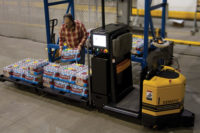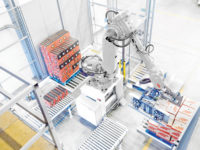AGVs maximize production, ROI for warehouses
Suppliers introduce new AGVs to beverage market

In “STAR WARS” movies, Jedi Master Obi-Wan Kenobi teaches a young Luke Skywalker about the power of “The Force.” Although not characters in “Star Wars,” automated guided vehicles (AGVs), just like the sci-fi franchise, are becoming “an epic force” in beverage warehouses.
Experts note that the interest and adoption of AGVs rapidly is accelerating in the face of a diminished labor pool and the fact that robotic lift trucks are designed to handle repetitive tasks while allowing labor to be redeployed to more value-added tasks.
Mick McCormick, robotics business leader at Yale Materials Handling Corp., Greenville, N.C., notes that traditional AGVs need to have a human operator while robotic lift trucks like the ones deployed by Yale are designed to independently operate or can be changed to manual mode with the touch of a button in case of an unplanned/unique requirement.
“Standard lift trucks are outfitted with infrastructure-free navigation technology to allow them to function autonomously, moving and lifting/lowering — all without a human operator,” McCormick says. “Their deployment allows labor to be redeployed to more value-added roles, leaving robotic lift trucks to handle repetitive, low value tasks like point-to-point transportation.”
At ProMat this year, Yale introduced a robotic reach truck, the first pantograph reach truck automated as a dual-mode robotic lift truck that can store and retrieve pallet loads from locations as high as 30 feet, the company says. “The pantograph allows it to reach into double-deep storage to maximize storage density,” McCormick explains. “This capacity to ‘go high’ and reach deep into storage racks enables operations to take full advantage of a facility’s storage potential.
“… The robotic reach truck uses a combination of sensors and 3-D cameras for maximum precision and effectiveness at higher-level storage locations,” he adds.
In February, the Yale MPE060-080VH end rider featuring smart-shift technology was launched. It features an optional extended platform to prioritize operator comfort and a Precision Pick feature, which enables precise bi-directional control of speed and coast functions at the press of a button, allowing operators to easily navigate between pick locations, the company says.
“Order picking accounts for 50-75 percent of operating costs for the typical warehouse. What’s more, operator productivity can decline by as much as 30 percent near the end of a shift,” says Chris Murtha Yale’s brand manager. “We worked to address these pressures with the new end rider, and it shows. The truck is designed to keep total cost of operation to a minimum and packs a laundry list of features to keep operators focused and productive.”
Dual-function solution
To keep pace with demand, equipment suppliers are releasing new products such as smaller sized AGVs and increased software advancements that enable multiple AGVs to operate under a single software control system “allowing the AGV to be thought of more as a solution and not just a product,” says Mike Kotzian, senior sales manager for mobile automatic at Grand Rapids, Mich.-based Dematic.
There also is an increased interests in hybrid AGVs, which Kotzian explains are manual operating lift trucks that are paired with an automation kit that creates a dual-use or hybrid machine that operates manually or as a fully functioning AGV.
“We unveiled a very narrow aisle (VNA) version of this at the ProMat tradeshow earlier this year. We took a VNA Turret truck designed and manufactured by Linde with automation controls by Dematic,” Kotzian says. “The Dematic automation kit enables the vehicle to drive, navigate and handle pallets — anything a manual VNA truck can do, but without a person in the driver seat.”
Specifically within the beverage industry, Mark Longacre, applications engineering manager for AGV at Chalfont, Pa.-based JBT Corp., is noticing “an influx of investment” in the AGV industry with customers making a bigger push for larger systems. “This investment is being used to develop new sensors, battery/charging, navigation, fleet optimization and system integration technology,” he explains. “The result is safer AGV systems that can do more work. Systems that could not be justified a few years ago are now providing quick payback for customers.
“… Clients coming to us now recognize that AGVs can reduce labor and help them solve their decreasing labor pool/increasing wage pressure challenges,” Longacre continues. “They are past the phase of testing AGVs in small-scale trials and have moved on to wide scale deployments where they can realize the full financial benefits of automation.”
Developing a plan
Given the plethora of forklift options, Dematic’s Kotzian suggests beverage manufacturers consider the following factors:
- Size of operation — how many shifts and days are you operating? How large is your facility? How are you currently storing product?;
- Environmental — what is the layout, height clearance, tolerances, humidity, temperature, lighting, air flow, etc., in your facility?; and
- Load — what type of load are you transporting? What are the dimensions and weight of the pallets? Are you looking to carry a single pallet or multiple pallets?
JBT’s Longacre suggests that beverage manufacturers develop a plan detailing where they want their business to be in three to five years. “Consider the technology that will help get them there,” he says. “How many lines will they run? What will be the output? Will they need to automatically load trailers?, etc.”
Safety is “hands down” the biggest benefit AGVs can offer, Longacre adds. “I don’t think a manual forklift will ever be as safe as an AGV,” he says. “We are held to a higher standard and meet that standard every day.”
AGVs also offer more value, according to Longacre. “AGVs can operate for an equivalent value of as low as $3.30 per hour. Compare this with what you pay for a manual fork and driver for multiple shifts and you will see how quickly the savings can add up,” he adds.
JBT offers a broad line of standard and purpose-built AGVs with capacities in the 1,000 to 10,000-pound range, he says. Among its standard vehicles are its counterbalance vehicles that can be outfitted with various height lifts and attachments and in three capacities: 1,500; 3,000; and 5,000 pounds.
AGV technology continues to progress as suppliers navigate changes in tracking and operation. “Early material handling AGVs required extra infrastructure like ground wires, tape, magnets and reflectors to navigate fixed routes,” Yale’s McCormick explains. “But today’s robotic lift trucks do not require an infrastructure and can adjust routes on the fly. This offers great strides forward in terms of flexibility, ease of use and productivity.”
As a fast-growing application in beverage warehouses, JBT’s Longacre notes that some AGVs focus on horizontal movement while others can provide both horizontal and vertical movement. “AGVs can block stack pallets on the floor in deep lanes and interface with various types of racking including select, double-deep, drive-in, push back, flow-through and even pallet shuttles,” he says. “And AGVs do more than just move pallets. They typically track movements too. So they can help with [first-in, first-out] (FIFO) and product consolidation.
With upscale technology, wide-scale deployment across multiple sites and a shrinking label pool, AGVs will continue to flourish in the beverage industry.
Citing ABI research, Yale’s McCormick estimates that more than 4 million robots will work in 50,000 warehouses by 2025.
“With an ROI that can be as little as a year, AGVs offer a compelling business case,” Dematic’s Kotzian says. “A single AGV can perform the same duties as multiple forklift operators, working over several shifts. They can save a company thousands in salary dollars.” BI
Looking for a reprint of this article?
From high-res PDFs to custom plaques, order your copy today!






